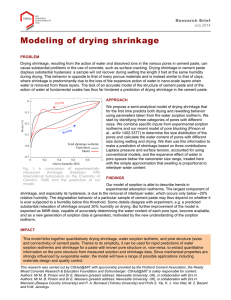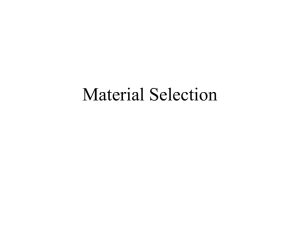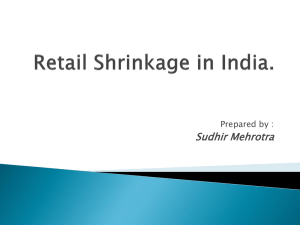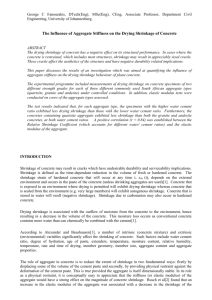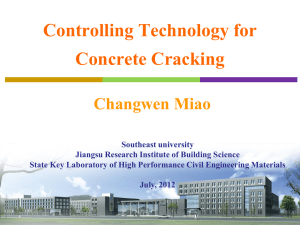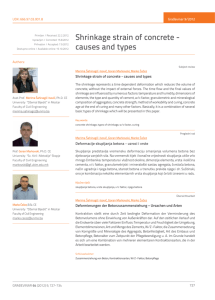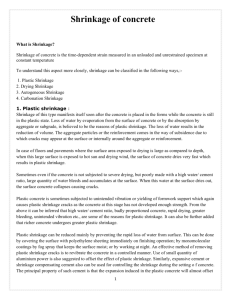Class 27.1 CIVE 2110 Concrete shrinkage creep thermal
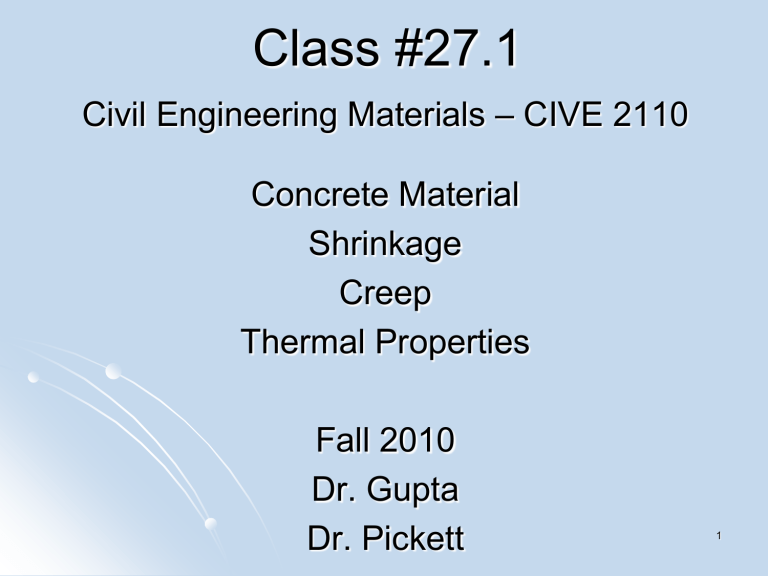
Class #27.1
Civil Engineering Materials – CIVE 2110
Concrete Material
Shrinkage
Creep
Thermal Properties
Fall 2010
Dr. Gupta
Dr. Pickett
1
Time-Dependent Volume Changes
(MacGregor, 5 th ed., pp. 70-83)
Concrete volume changes over time due to :
(1) Shrinkage;
Negative volume change due to curing, drying,
- shrinkage is less in a structure than in a cylinder,
- rebars restrain shrinkage,
- less exposed surface area per volume,
- structure is built in stages, shrinkage not simultaneous throughout structure.
- in a parking garage, concrete absorbs CO
2
,
- shrinkage due to carbonation = shrinkage due to drying.
(2) Creep;
Volume change due to load over time,
(3) Thermal Expansion/Contraction;
Volume change due to change in temperature of mass.
2
Time-Dependent Volume Changes
(1) Shrinkage:
(MacGregor, 5 th ed., pp. 70-83)
Negative volume change, shortening, under constant temperature due to;
Drying & hardening: causes water to evaporate from cement paste, causing shrinkage to occur;
- aggregate does not evaporate, does NOT shrink;
Shrinkage;
Increases with decreasing humidity,
Increases with increasing cement-to-aggregate ratio,
(Fig. 3.22a,
MacGregor, 5 th ed.)
Cement paste shrinks, aggregate does not shrink.
Increases with increasing water-to-cement ratio,
More water, less aggregate,
water evaporates, paste shrinks, aggregate does not shrink.
Increases with increasing fineness of cement,
Finer cement absorbs more water, water evaporates, more shrinkage.
Decreases with increasing member size,
More mass per exposed surface area, less shrinkage.
3
Time-Dependent Volume Changes
(1) Shrinkage:
(MacGregor, 5 th ed., pp. 70-83)
Equation for Axial Shrinkage Strain between days t s t , t s
cs
s
cso
s
s
& t in plain concrete:
cso
= basic shrinkage strain, for a specific concrete & relative humidity,
= coefficient, a function of time and member effective thickness, s
(Fig. 3.24,
MacGregor, 5 th ed.)
s
s
350
h e
t h
0
t s
t
1 t
t s
t
1
0 .
5 h e t = age of the concrete, days, t
1
= 1 day
2 A u c t s
= age of concrete at end of moist curing, days,
A c
= concrete cross sectional area, in 2 .
h
0
= 4 in.
Time-Dependent Volume Changes
Equation for Axial Shrinkage Strain between days t s
cs
s
cso
s
s
& t in plain concrete:
(MacGregor, 5 th ed., pp. 70-83)
cso
= basic shrinkage strain, for a specific concrete & relative humidity,
cso
s f cmo
= 1450 psi,
cm
RH
s
cm
1 .
2
160
sc
9
f f cm cmo
10
6 f cm f cm
= mean compressive strength, at 28 days, psi,
f
' cr
' ' from ACI 318, Sect. 5.3.2.1, or assuming a standard deviation of s
0 .
15 f f f
' cr
' cr
f c
'
1 .
2
f c
'
1 .
34
0 .
15 f c
'
f cr
' f cr
'
f f c c
'
'
2 .
33
1247
c
'
0 .
15 f
f
' cr c
'
f c
'
2 .
33 s
5000
500
500
2
'
Use = smaller of or
sc f c
'
1200 psi
= coefficient accounting for type of cement
sc
5
Time-Dependent Volume Changes
(1) Shrinkage:
(MacGregor, 5 th ed., pp. 70-83)
Equation for Axial Shrinkage Strain between days t s
cs
s
cso
s
s
& t in plain concrete:
cso
= basic shrinkage strain, for a specific concrete & relative humidity,
cso
s
cm
RH
RH
= coefficient accounting for relative humidity,
RH
= +0.25, for Relative Humidity ≥99%
(Fig. 3.23,
MacGregor, 5 th ed.)
For Relative Humidity 40% < RH < 99%
RH
1 .
55
1
RH
RH
0
3
RH = Relative Humidity of ambient atmosphere, %
RH
0
= 100%
6
Time-Dependent Volume Changes
(1) Shrinkage:
Example calculations:
(MacGregor, 5 th ed., pp. 74-76)
Underground parking garage,
Floor slab, 6 in. thick, lightly reinforced,
Floor restrained on outside edge by 16 in. thick basement wall,
Walls 26 months old, moist cured, 5 days, cast against ground,
Slab 24 months old, moist cured, 5 days, not on ground,
Relative humidity, roughly constant over period, 50%,
Concrete; Type I cement, f c
'
3000 psi
Shrinkage for reinforced concrete ≈ 0.75 shrinkage plain concrete
Cracks developed in slab, perpendicular to wall, at roughly every 6 ft.
Assume cracks resulted from restraint by wall of slab shrinkage parallel to wall.
Calculate crack width.
7
Time-Dependent Volume Changes
(2) Elastic Strain
plus
Creep Strain:
Example calculations:
(MacGregor, 5 th ed., pp. 79-81)
Concrete pedestal, plain (unreinforced), 24”x24”x10’
Moist cured, not on ground,
Applied load 1 month after casting,
Load causes average stress = 1000 psi.,
Temperature, roughly constant over period, 68 ˚F,
Relative humidity, roughly constant over period, 50%,
Concrete; cement content = 675 Lb/yd 3 , slump = 3 in.
Compute total shortening in 5 years.
8

